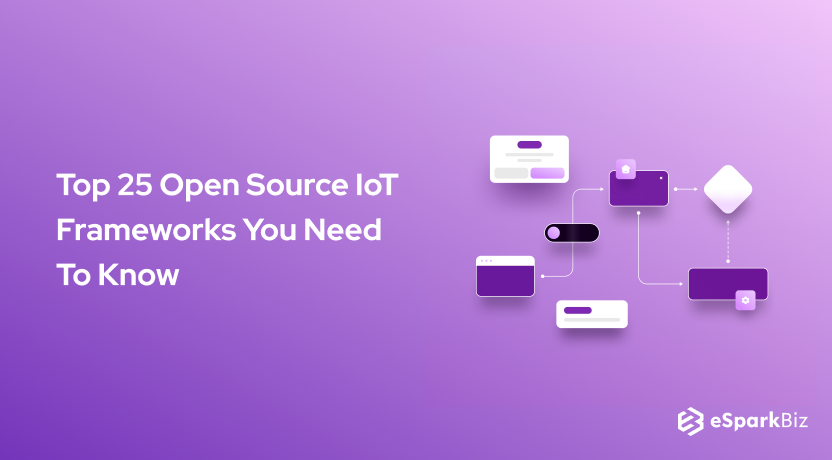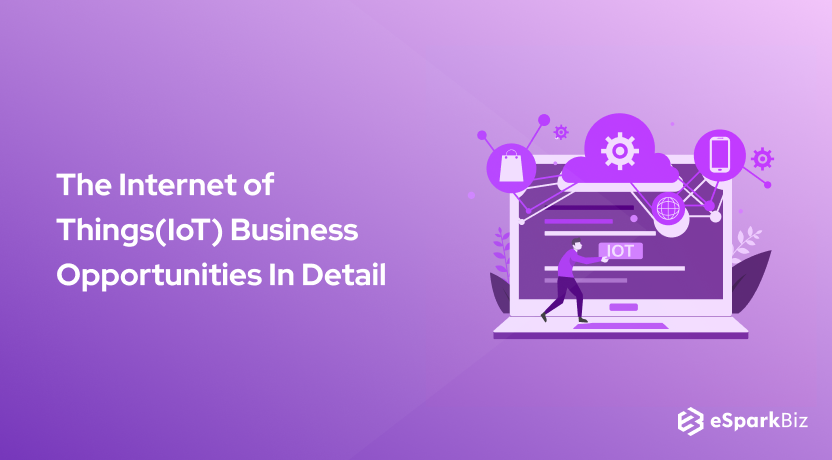Since the last couple of years, human beings are getting more and more addicted to IoT devices. It has started becoming one of the important and irrepealable parts of our lives. Today, we’re going to talk about Node.js For IoT in detail.
But the question is what is IoT and which devices can be counted as IoT devices.
In simple terms, The Internet of Things (IoT) devices are devices that can be connected to the Internet, sensors, and things.
Devices that can reach and communicate with others over the Internet, and can be remotely controlled and managed. Open-Source IoT Frameworks are playing a major role in that.
Examples of smart devices are:
- Smart Home (eg. smart lights, smart ACs)
- Wearables (eg. Fitness Trackers, Smart rings)
- Driverless Cars
- Doorbell cam
- Smart lock
- Smoke alarm
Business Opportunities With IoT
As you know about IoT, the question will pop up that what’s your profit in it, right? At the end of 2019, there were 7.6 billion active IoT devices.
The number of active IoT devices will reach 24.1 billion in 2030. Doing a simple calculation can tell that till 2030 the average devices held by a single person will be 5-7 IoT devices.

Speaking about Market revenue in 2019, it was worth US$465 billion. It will reach US$1.5 trillion by 2030.
Services including connectivity are estimated for 2/3rd of spending with the rest accounted for by hardware, in the form of dedicated IoT devices, modules, and gateways.
It could be anything like a smart watch? A smart TV? Or a smart car? I can bet even you own one. Now you can assume where this is going, right? Get your brand future ready to be in the list of IoT devices one owns from these 5 to 7.
Reasons To Choose Node.js For IoT in 2024
Fast & Performance
The IoT devices are constantly working with regularly changing data and that needs developers to work with a framework that can manage real-time applications and heavy data flow.
Node js is a very powerful and absolutely scalable framework and is built with Google’s V8 JS engine. Constantly changing data is not a challenge for it either. That’s the reason why we need node.js developer and they choose Node js above all for developing real-time apps and platforms.
Easy To Integrate With IoT Protocols

IoT applications actively handle a publish-subscribe-based messaging protocol, MQTT. In turn, for transportation and encapsulation, this protocol employs WebSockets. Both MQTT and WebSockets are well-supported and efficiently integrated by Node.js.
Modules Support IoT Development
The features that are most useful in IoT are npm, NodeRed, etc and Node.js is augmented thereupon. There are around 80 packages for Intel IoT Edison, Arduino, or Raspberry Pi.
Also, it highlights 30 packages for various sensors, beacons, and other tools, which will make IoT development much simpler and faster with Node.js IoT modules.
In general, developers’ needs are not as complex as their coding. A framework with fewer resources can fulfill their needs.
The fewer resources include the CPU and RAM that doesn’t overload and a framework that can promise high scalability which is definitely important for most modern companies.
Node js. is the perfect match for that. Of course, not all the companies are a fool to choose Node js above all. Companies are opting for rent a coder India and are achieving great IoT-Node js development success.
Event-driven/ non-blocking
Another reason to choose Node js is in it’s own name as Node js stands for – “non-blocking I/O” – it provides effective efficiency, and high performance for IoT Applications. That’s why Node JS For IoT apps is a dream combo.
Open Source

Node.js is an open-source framework. Some years back the future of Node appeared unclear when a group of Node developers and contributors drifted apart the Node.js source to form IO.js.
However, after some time the IO.js and Node.js joined together as one under the Node.js Foundation. That’s why IoT For Node.js is a great combination.
Scalable and Portable
Systems, devices, things, and sensors support for working Node on ARM platforms and processors. Unnecessary to assume that it works on all kinds of Edge Devices – Gateways, Concentrators, Routers – in fact, any platform that supports Linux is expected to support Node.
What this indicates is that for developing a classified software system across your workflow, especially in IoT, Node and JavaScript help you to build a comprehensive end to end application.
The ability to develop a classified software system also supports working “cloud” apps on the edge without Internet connectivity. Professionals at eSparkBiz highly recommend using NodeJS For IoT App Development, as it offers easy integration with cloud services making the end result robust as well as secure for use.
This is exceedingly useful in use-cases such as Healthcare (performing surgeries or medical checkups) and challenging a system that can work without being connected to the Internet.
Lots of Readymade Plugin
A set of openly accessible, reusable segments, open through secure and simple installation via an online closet, with version and dependency management by practicing npm.
Low Resource Requirements
The framework requires really fewer resources. Node.js has an individual process thread. It occupies one single CPU core at the time because load balancing is the keyword of Node.js. Node.js has V8 standards.
Ready For Enterprise Deployment
Node.js is a privilege for scaling well, staying secure, and also easy to learn. That’s the reason it is engaging in a wide range of the tech community.
It’s not difficult for a developer to pick up JavaScript and soon become fertile with it. Along with PayPal, LinkedIn, Netflix, and the New York Times, many well-known companies are using Node.js Development.
Managing and Securing Data

IoT is all about collecting data, communicating, analyzing, and acting. Node js is known for its acceleration, scalability, and performance delivering it the key player for data-intensive real-time application.
This makes Node js completely fit for IoT which relies on data-intensive real-time traffic. Node JS For IoT is a perfect partner for all the IoT features.
Challenges With IoT App Development
Security Matters
As mentioned above, 26.66 billion devices are connected to the interface and transfer the data they require to work accurately.
This data is an engaging victim for devious developers, who try to seize the data stream and apply it to achieve their own intentions.
For IoT devices security lies in three main parts:
- Accurate and precise code structure
- Access rights for various types of operative
- Affirmation of devices and users authenticity
Secure Authentication

Tokens are a great way to set up authentication as they let you recognize a specific user and decide whether to grant or deny them access. A token can be encrypted with any algorithm.
However, the hardware (scanners, sensors, hubs, or other IoT things) should collect this token or login/password data in firmware. This means that violators can seize the token if they have real access to the hardware.
Secure HTTP Requests
In Node.js, it is considerably simple to execute HTTPS configuration and certification. HTTPS uses SSL or TLS protocols for data encryption.
const express = require('express');
const https = require('https');
const http = require('http');
const fs = require('fs');
const options = {
key: fs.readFileSync('path/to/your/key.pem'),
cert: fs.readFileSync(path/to/your/certificate.cert')
};
const app = express();
http.createServer(app).listen(80);
https.createServer(options, app).listen(443);
This is how you could use a signature:
const fetch = require('node-fetch');
const verifier = crypto.createVerify('RSA-SHA1')
const SIGNATURE_FORMAT = 'base64';
//check if it trusted url for your certificate
const trustedUrl = ‘https://trustedUrl/’
const isTrustedUrl = trustedUrl.match(url);
If (isTrustedUrl) {
verifier.update(req.body, 'utf8')
fetch(isTrustedUrl)
.then(certificate => {
// check signature
const isValidSignature = verifier.verify(certificate, reg.header.signature, SIGNATURE_FORMAT);
})
.catch(err => console.log(err));
}
One can apply extra data encryption to verify whether you have received a request from a certain server or client.
- First, you should check the trusted URL of your certificate.
- Then, you sign a request body with the public key from your certificate.
- Finally, you match the signed body with the signature from headers.
AI Threat
Developers employ AI to Analyze the processing of massive amounts of data. It automates many processes and makes the developer’s life more peaceful.
In this case, developers require to regularly change these algorithms and can never be sure what they just uploaded to the system.
With minor human interference, some of the variables can unexpectedly associate with each other and it is laborious to predict the outcomes. That can be the biggest obstacle for artificial intelligence.
Not understanding the ways IoT works
IoT is not as simple as it sounds. It can create hurdles in your life if you ignore acquiring the basic knowledge of the Internet of Things development. Before jumping on a big project, you should always start with something small.
If you fail to do so, at the end of the day, your absence of experience may cripple not only your credit as a developer but also the entire company.
Read also: Top 25 Open Source IoT Frameworks You Need To Know
Real-Time Examples Of Using Node.js For IoT Apps
Asama
It is a smartwatch that uses a micro-location system and Bluetooth beacon to convey a regular signal. The Asama is specifically designed for employees and employers.
It let’s employers track the actions and activities of employees including identifying the owner of the watch.
With the Bluetooth beacon signals, employers can keep watch on employee’s actions, locations in real-time.
It also tells whether the employees are coming too late or going too early, absent from the workplace, not being active throughout the day, or not catching routes and schedules, sleeping, or had left their place.
Monitoring the actions and forwarding it to the concerned person is the foremost work of Asama. The collected data of employees are forwarded to the mobile app installed and configured on the employer’s phone.
At the end of the week it will give the extensive report of employee activity to the manager.
This report can be helpful to encourage the company’s achievement and productivity of the employee. The system is powered by Node.js in IoT.
PREE
PREE is designed for the people who keep misplacing and forgetting their items. Pree’s system of BLE signals and mobile software helps people prevent missing their stuff.
It can track and send you the notifications if you have forgotten the phone, bag, keys, wallet, or any other important belongings.
Not only to you, it can send a notification to your family or friend’s number whose data you have given to the system.
If the owner has forgotten any of his/her belongings the system will identify the location of their stuff in real-time and assign it with believed contacts. You will receive the notification if the thing is out of your range.
You can even set the range in the home where you can mute the system and it won’t spam you or your loved ones with the notification.
Pree system is developed using Node.js, Express, and Mongo on the backend and Ionic with Cordova for the frontend. The aggregate of these frameworks guarantees the best user experience.
Johnny-Five.io
Johnny-Five is the JavaScript Robotics & IoT Platform. Released by Bocoup in 2012, Johnny-Five is maintained by a community of passionate software developers and hardware engineers.
Over 75 developers have made contributions towards building a robust, extensible, and composable ecosystem.
It’s created for anyone who desires to start with JavaScript-powered robotics. The J5IK adds a Tessel 2, and everything more you want to do 14 experiments! No programming or soldering knowledge is needed.
N|Solid For IoT
The N|Solid platforms are exceptionally important in IoT use cases because of the way its protocol operates.
It moves code data apart from the particular device which might have restricted storage or availability, or may not be secure out to cloud-based, user-determined and controlled storage.
In case of quality confidence, developers can debug and get higher visibility into processes through product bake-in, huge value add, and tremendous resource saver.
Its architecture allows temporary artifacts to be moved to a permanent, user-determined location. Even if the process goes down, the artifacts remain long after a crash or device termination.
Visibility, insight, and post-mortem debuggability are necessary for triaging and resolving problems quickly and effectively.
NodeSource saves time, money, and resources in finding and fixing a bug that could take out internal business processes, applications, or APIs that are affecting customers or partners.
OneTesselAway
The OneTesselAway backend software is a Node.js JavaScript application that runs on the Tessel 2.
After initializing the hardware, it starts polling the OneBusAway API for bus arrival messages every 5 seconds. When a new arrival message is received, the LCD screen and other segments update accordingly.
The OneTesselAway backend application also starts an Express.js web server that serves the web UI frontend application.
The web UI is also a JavaScript application, but it works on the user’s web browser. It emphasizes affected hardware that is synchronized with the backend application and hardware components.
For example, the simulated LCD screen should always promote the same arrival times as the physical LCD screen.
Conclusion
You have learned everything you should know about Node js. and IoT. I think I have made my point about how Node js and IoT can be the perfect companion.
I must say it is not the end, It is just the start of IoT. Keep looking forward to knowing more about Node js and IoT.
We hope you all had a great experience reading this article and it proves to be a great help to any iot development services in the near future. Thank You.!
-
Which IoT applications are most beneficial?
Wearables
Health
Traffic monitoring
Fleet management
Agriculture
Hospitality
Smart grid and energy saving
Water supply -
What applications use node JS?
Top apps using node JS:-
LinkedIn
Netflix
Uber
Trello
PayPal
NASA
eBay
Medium -
What is node js best used for?
Node. js due to its single-threaded nature is primarily used for non-blocking, event-driven servers, It's used for traditional web sites and back-end API services.
-
Is node js a good backend?
Node. js is called real-time applications (RTA). A good choice for applications that have to process a high volume of short messages requiring low latency.







